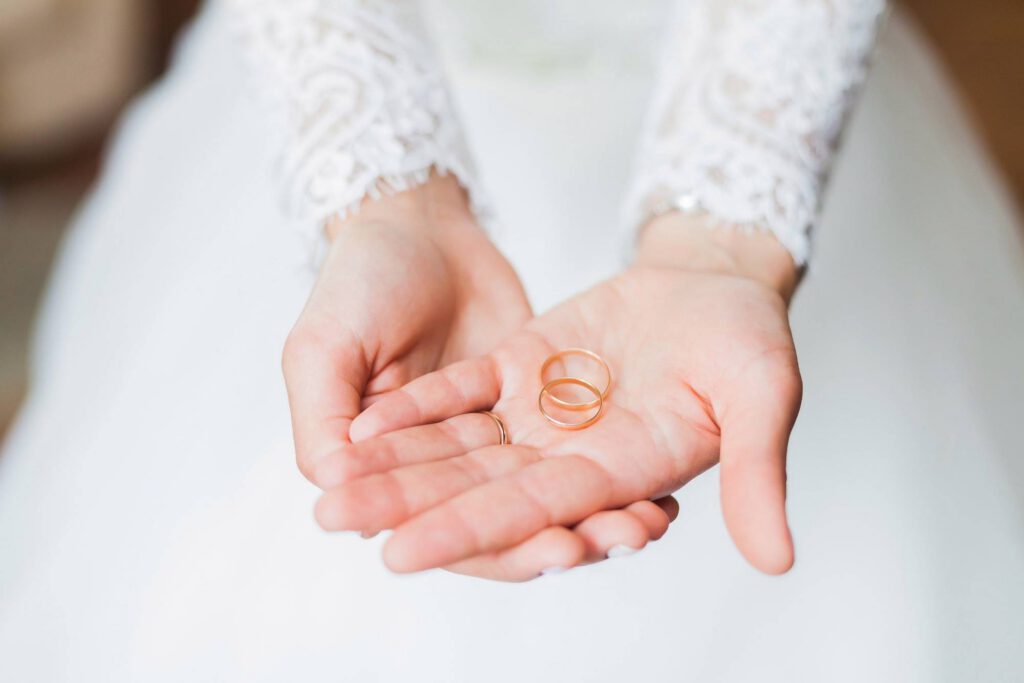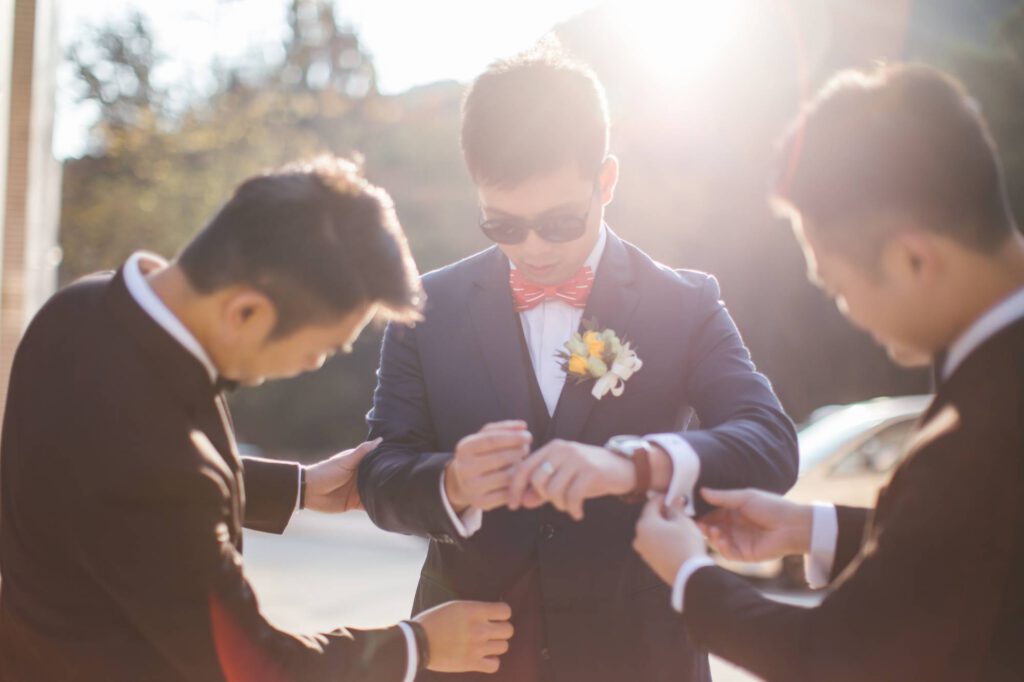Greek wedding traditions provide a popular theme for many couples looking to celebrate their wedding amongst family and friends. Stemming from thousands of years of ancient and religious rituals, brides and grooms have a plethora of traditions before them that can be incorporated into both the wedding ceremony and reception, whether marrying in Greece itself or another beautiful destination.

The engagement
As is custom in the UK, it is important for the couple declare their love with an engagement ring. However, in greek tradition, both the bride and groom exchange engagement rings, usually in front of their family, which are placed on the left hand. The rings then become the wedding bands that are used in the ceremony.
Planning the date
The Greek Orthodox Church imply that good fortune may befall the couple if they choose to marry in January or June, as those months are dedicated to celebrating Hera, wife of Zeus and goddess of marriage and fertility. Whilst Sunday is the preferred day for a wedding, certain dates are forbidden due to religious customs:
- During Lent
- The first two weeks of August (a time to celebrate the Virgin Mary)
- 40 days preceding Christmas
- August 29th (as it marks the beheading of St John the Baptiste)
- September 14th (marks the celebration of the exaltation of the Holy Cross)
Odd numbers are also incredibly lucky as they can’t be divided, which is what we hope for the wedded couple, so selecting an odd date for the wedding could prove invaluable.
Preparing the marital bed
One of the most important of the Greek wedding traditions is the preparing of the marital bed by friends and family. The bride and her attendants make up the bed, which is approved in turn by the groom. The family then throw onto the bed money, for prosperity, and rice to symbolise the couple putting down their roots. The final element of this tradition involves rolling a baby across the bed to guarantee fertility. The gender of the baby will depict the gender of the first-born child.
The Bride
Many brides will rarely follow the dress code indicated by greek tradition, as every bride and their style is different. But for those looking to strictly follow the ancient customs, the grecian gown is gathered at the waist with soft, floating material that drops to the floor, showing the sensuality and athleticism of the Gods. It used to be that veils of yellow or red were also worn to ward of evil spirits. To complete the outfit, the bride must adorn her shoes. The names of the all the bride’s unmarried friends that are in the bridal party are written on the bottom of her wedding shoes, and whoever’s names have rubbed off by the end of the wedding night are the names of the women soon to be married. Once dressed with the help of her Maid of Honour, known in Greek tradition as the Koumbara, and her bridesmaids, the bride will leave with her father to head to the ceremony. She is told by her mother to look back at the house one last time to ensure her children take after that side of the family. The bride can also bring herself more luck by placing a lump of sugar inside her glove, for a sweet life, or by walking down the aisle with a gold coin in her shoe to bring her prosperity. Contrary to traditions here in the UK, it is the groom that holds the bride’s bouquet. When the bride is presented to him by her father, the groom hands the bouquet to her.
The Groom
The groom’s traditions of dress are far less exact than the bride, however they can place a piece of iron in their pockets to ward of evil spirits. The groom’s best man is called the Koumbaro. This would traditionally be the groom’s godparent, however, should circumstances call, the bride’s godparent is asked, followed by a close friend or family member. The honour of becoming the Koumbaro is extremely high, as they are blessed with baptising the first-born child, as well as becoming the godparent. Before the wedding ceremony, the Koumbaro is tasked with shaving the groom to show the trust between them. The groomsmen then all assist in helping the groom get ready.

The guests
Many in the Greek Orthodox religion are very wary of the evil eye – a term used to describe jealousy, bad wishes and the evil thoughts of others. We hope such feelings would never be present on a wedding day, but there are a couple of greek wedding traditions that can be included to help keep the evil eye at bay.
- The attendants can all wear a blue eye symbol during the ceremony
- Spitting three times either side of the wedding dress whenever the eye is mentioned or a compliment is paid
Whilst spitting is a firm tradition, as you can imagine the preferable one today is to offer the blue eye to guests.
The ceremony
The wedding ceremony can last an hour or more and is split into two sections; the betrothal and the marriage service. The couple hold their right hands together throughout the ceremony to symbolise their unity. The betrothal begins with the blessing of the rings by the Priest. He blesses both the bride and groom three times, named for the Father, the Son and the Holy Ghost. The wedding rings are then placed on the tip of their fingers and the Koumbaro steps forward. He swaps the rings back and forth three times, before placing the rings on their right hands. That is where the rings will remain throughout their marriage. In true Greek wedding tradition, it is not required for the bride and groom to exchange vows, as the blessings of the Priest and the witnessing of the congregation are thought to be enough to cement the union, however many find this is the ideal place for the couple to exchange their own vows and compliments of each other. After this, the holy candles are lit to symbolise the light of Christ. This is usually one candle that the couple share to hold during the ceremony, but sometimes two candles are preferred. These are then left in the church or taken home after the wedding, but it is important that the candles are not thrown out. They must be left to burn down completely to ensure a long life together.
The crowning
We then move on to one of the most important parts of the ceremony; the crowning. The Priest will hold the crown, or ‘stefana’, in his right hand and bless the groom three times before placing the crown on his head, which he will then repeat for the bride. The Koumbaro steps forward once more to swap the crowns three times – like we say, odd numbers are very lucky in greek tradition. The crowns are often made of gold and connected by a single white ribbon symbolising the union of two people that shall rule the household together. Some couples choose to decorate the crowns together with more personal touch. Using white flowers and evergreen leaves are to boost fertility, orange blossoms and roses are for purity, and even olives and herbs such as basil and thyme can be woven throughout. After the crowning, the Priest will pour wine into the ‘common cup’ – a single wine glass that is shared three times between the couple to symbolise the sharing of life. After sharing the wine, the cup, candles and bible are placed on the alter. The Priest takes their hands and walks them around the table on their first journey as a married couple, one of many for the newlyweds. The Priest performs a final blessing of the couple and removes the crowns.
The reception
Whilst the ceremony is a very formal affair, the reception is often considered the biggest party of them all. A real celebration of the happy couple. Many of you may know of the greek tradition of smashing plates. Quite often nowadays couples will opt for the cheaper and safer option of plaster plates, though it is a tradition that is rarely conformed to. Dancing is the part that many in the Greek Orthodox Church look forward to most. From the Tsamiko to the Zeibekiko, each dance brings the family and friends together. The Kalamatianos is the most well known, which involves the party holding hands in a circle and moving around anti-clockwise to traditional rhythmic music. The last dance is reserved solely for the bride and groom, and whilst they finish the evening in each others arms, the guests come forward and pin money to their clothes. At the end of the night the guests are given their wedding favours; a small bag of Jordan Almonds (Koufeta in Greek). There is an odd number in each bag, of course, and each element of the almond has a meaning. The sugar coating wishes the couple’s life will be sweet, the egg shape symbolises fertility, and the crunchy texture indicates the endurance of marriage. Whether you wish to conform strongly to the greek wedding traditions mentioned above or just select elements of certain parts, the symbolism of each custom is really the part that should guide your decision. What do you believe in and what do you want your marriage to be about?

